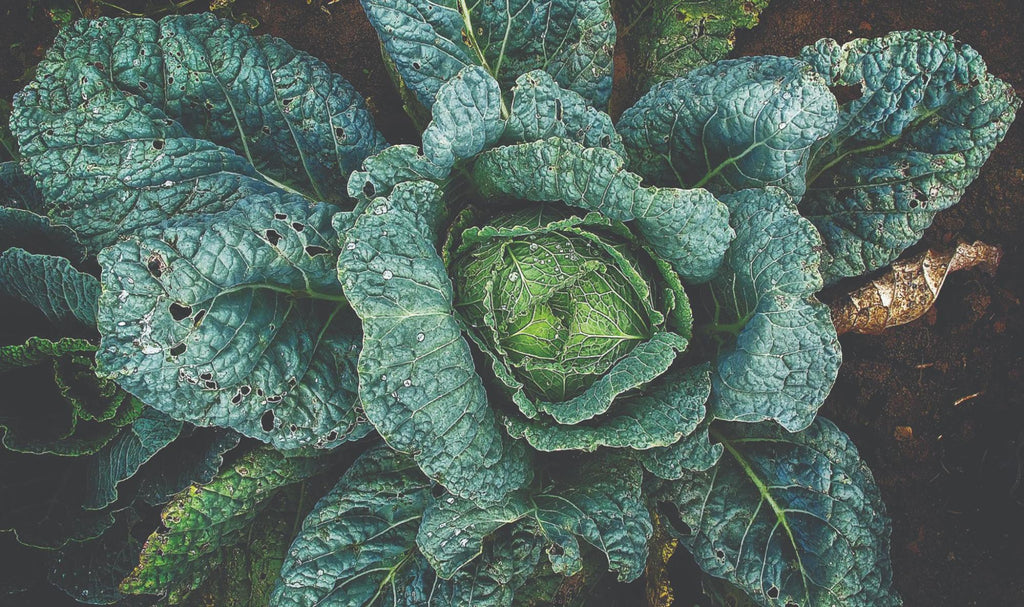The Different Types of Cabbage: Napa, Savoy & More

Cabbage is a wonderful cool-season crop for gardeners who want abundant and versatile greens. All sorts of cabbage can be great for adding crunch to dishes, sauteing, roasting, and pickling. Some can even be stored fresh for months, providing homegrown greens well into the winter. So how to choose what kinds to grow in your garden? Here’s a guide to the different types of cabbage to help you pick one that’s a good fit for your garden and your cooking style.
The Four Main Types of Cabbage
All cabbages are members of the Brassica family that have been selected by plant breeders to produce large heads of tightly-packed leaves. They are the “cousins” of other Brassicas like broccoli and cauliflower (selected for large edible flower stalks), brussels sprouts (selected for cabbage-like side shoots), and kale (selected for loose leaves to harvest over time). Most cabbages can fit into four main subcategories: green, red, savoy, and Chinese (or Napa).

Green Cabbage, Brassica oleracea var. capitata f. alba
Green cabbage varieties have round or pointed heads and are the classic kinds for making coleslaw and sauerkraut. They originated in Europe along with red and savoy cabbages, all of which are of the species Brassica oleracea and the varietal capitata (latin for “headed.”) The last part of their botanical name, alba, means white, referring to these cabbages’ pale color. Green cabbage is sometimes also called white cabbage for this reason.
Green cabbages' Northern origins mean they are frost hardy, and many are good for storing into the winter. Early Jersey Wakefield is a quick producer of 2-pound, conical-shaped heads, great for spring or fall planting. Charleston Wakefield forms a similar type of head, but is particularly heat tolerant, a little larger, and a better keeper. It’s ideal for Southern gardens, and late summer planting for fall harvest.

Red Cabbage, B. oleracea var. capitata f. rubra
Red cabbages have all the characteristics of green cabbage plus they are packed with anthocyanin pigments, which means they are both beautifully colored and loaded with healthy antioxidants. Red Acre is an early-maturing variety with 2- to 4-pound round heads and gorgeous reddish-purple leaves. Its compact plants are ideal for home gardeners with not a lot of space.

Savoy Cabbage, B. oleracea var. capitata f. sabauda
Savoy cabbage is named for the Savoy region of France and prized for its distinctive frilly and crinkled leaves. The term “savoyed” has come to mean crinkled leaves on any vegetable, and is often applied to certain varieties of spinach.
Savoy cabbages are also known for particularly strong frost tolerance (down to 15 degrees Fahrenheit!), especially sweet and mild flavor, and tender leaves. They are the best of the European cabbages for eating raw in salads or as wraps. Perfection Savoy is a variety that is tolerant of both heat and frost, making it a great choice for a fall garden. Its large, 6- to 8-pound round, green heads are good for winter storage as well.

Chinese Cabbage, B. rapa var. perkinsis
Chinese cabbage, also known as Napa cabbage, is the odd one out of the four main types, since it’s actually a different species - Brassica rapa. Whereas other cabbages are most closely related to broccoli and kale, Chinese cabbage is more closely related to mustard greens and bok choy (which is also sometimes referred to as Chinese cabbage, though it forms a much looser head).
Though Napa cabbage grows a sizable, tightly-formed head like the European cabbages, its shared lineage with mustard and Asian greens means it has a slight peppery flavor and a more juicy, crunchy texture. It’s particularly great when lightly cooked in stir-fries, or made into traditional kimchi. Long-term fresh storage, on the other hand, is not its strong suit, nor is weathering hard freezes, though it can withstand a light frost. Michihili is a popular Chinese cabbage variety that grows green, cylindrical heads about 14 inches tall and 6 inches in diameter.

Other Cabbage Varieties
There are a few other leafy greens that are sometimes referred to as cabbage, not because they form heads, but because of the cabbage-like texture of their leaves.
Jersey cabbage, also known as walking stick cabbage, or cow cabbage, is a rare variety from the Channel Islands known for growing to extreme heights (so tall you really can make a walking stick out of the stalk!) Traditionally, the lower leaves were fed to livestock, while people harvested the top cluster of new leaves to use like cabbage when the stalk reached full height.
Tronchuda cabbage, also known as Portuguese kale, is another example of a non-heading “cabbage,” whose hearty texture makes it great to use in soups similarly to other cabbages.
And, Morris Heading collards are sometimes known as Carolina Cabbage collards, for their cabbage-like texture and tendency to form a very loose head. These loose-leafed “cabbages” often begin producing harvest-able leaves earlier than traditional cabbage, and may be somewhat less susceptible to pest pressure than heading types, so if you’re not growing for winter storage or cabbage-specific uses like sauerkraut or coleslaw, they might be good options to try.
Hopefully that helps you decide what kinds of cabbage to plant in your garden! Shop our whole collection of cabbage seeds, or check out our article on how to grow cabbage for pointers on growing a successful cabbage crop.

|
Article Written by: Leah Smith |
|
About the Author: Leah Smith is the Seed Product Manager at Sow True Seed, where she focuses on adding new varieties to the catalog and ensuring the seed stock is top-notch. Her firsthand experience in farming has given her a deep understanding of cultivating crops while caring for the environment. |





